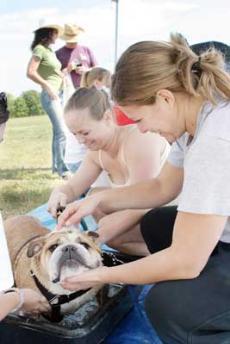“Can he pet your dog?”
A father questions a woman holding a leash.
“Sure,” she says, turning so the dog is closer to the little boy. He looks eagerly at the brown dog, with its yellow and orange tie-dyed bandana around its neck.
In the background, dogs bark and whimper, people cheer, an announcer talks over a PA system, lines form in front of tents and dogs and owners work to be the best in the competition.
At the Dog Olympics, held at the veterinary school Saturday, competitions varied. Best trick, wiener toss, doggie limbo, longest tail, dog and owner look-alike, best beggar, musical sit and roll over Beethoven were just a few of the contests.
Renae Wohlers, a veterinary school alumna, showed her “niece” — her sibling’s dog, Taylor — in the wiener toss.
“She didn’t catch it, but certainly enjoyed herself,” Wohlers said.
According to Wohlers, Taylor “normally has to sit to get her treats.” She said it was fun to come back to the event after volunteering for it while in school.
Kate Medl, a graduate student in veterinary medicine, volunteered. She helped with a ring, the place where the dogs competed. She said she helped decide the winners, organize the dogs and make sure all participants got their doggy treats.
She said her criteria for judging “depended on the event,” but for the “best trick competition,” she based her decision on “creativity and execution.”
Not everyone at the Dog Olympics was there to compete. Kristi Sluiter, a fourth-year graduate student in veterinary medicine, was there because she “wanted to get [her] dog out and meet people.”
Sluiter did not plan on entering her dog in any competitions because she said her dog was not trainable and a “couch potato” that lives up to the “greyhound theme.”
A main attraction at the event was the ability to have a microchip implanted in dogs for free, sponsored by the Raleigh Kennel Club.
According to William Hazelrigg from the Raleigh Kennel club, a microchip can be good because if raises the likelihood of owners finding their dogs.
Veterinary students were inserting the chips with a syringe in the soft flesh at the back of the dog’s neck, according to Hazelrigg. He said the procedure was good for the students because they get to practice inserting the microchip.
Hazelrigg said the microchip emits a signal, but made it clear that it was not a “Sony battery,” and the dog will not “catch on fire.”
Rebecca Redwine, an NCSU alumna, said she has been planning to put a microchip in her dogs for a while and decided this was a good opportunity.
She said her dogs stay home “most of the time,” but they like to wander “every once in a while.”
The staff of the event was pleased with the number of people who came to the Dog Olympics.
“I’m impressed with the turnout, and the line keeps going,” Nikita Singhani, a veterinary student, said.









